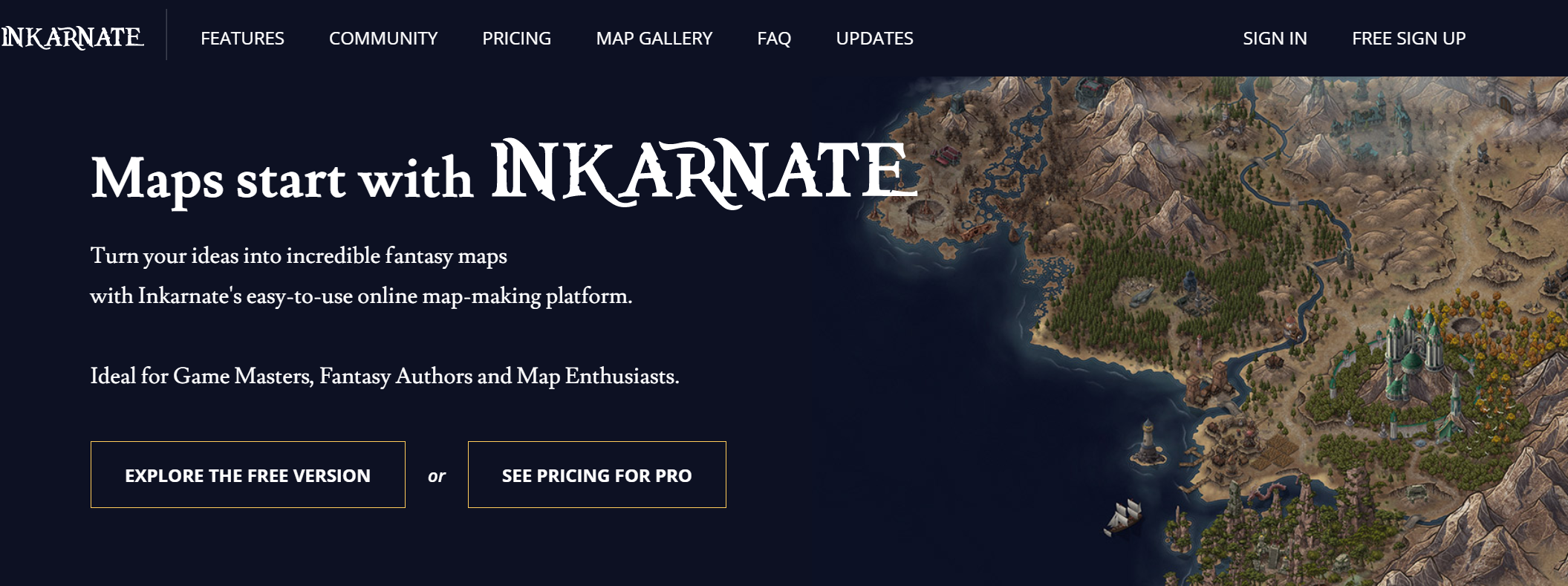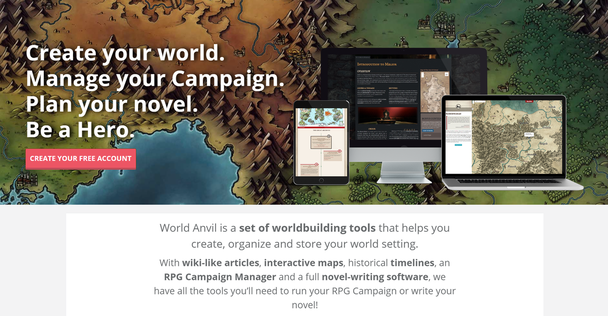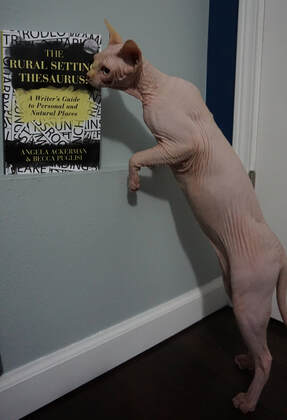|
Last week I reviewed World Anvil, the worldbuilding website but my biggest disappointment was the lack of map making capacity, especially because it featured so many images of maps! So I checked out the list of websites World Anvil recommended for mapmaking and spotted Inkarnate.
Overview Inkarnate is a mapmaking website. It’s advertised as being for making maps for fantasy worlds for game play (like D&D), writing, game design, etc. There are two tiers: paid and free. Free version: It’s free! You don’t even enter credit card info. It’s not a trial, it’s always free. Paid: You can pay monthly ($5/month) or annually ($35) and access the same material either way. The pro version allows you to access more items to put on your maps (like walls or different trees and cities), more frequent art updates, other mapmaking tools (like the advanced mode to specialize and have more freedom during creation), commercial use of your maps, higher resolution map exporting, and allows for your custom art alongside their Inkarnate art. Either free or paid, your maps are always only visible to you unless you “publish” it on their website. Both versions allow you to export (i.e. download) to your computer and/or save your map to your account. In the map making itself, there are different styles. They’re broken down into categories: world maps (Fantasy or Parchment style), Regions, Cities and Villages (including the optional Watercolor style), and Battlemaps (which also includes the interior of buildings). My Experience Inkarnate is aimed at fantasy worlds, and by that it’s clear they mean Tolkein-esque fantasy. If you’ve got something set in a non-medieval-Europe world, this is going to be a stretch for you. However, it can still work for zoomed-out big picture maps, which is how I tried to use it for my sci-fi. There’s a fairly helpful FAQ, but the tool itself can be difficult to figure out. It didn’t even use normal scrolling, so I kept accidentally zooming when I wanted to go right. I’m not exactly the most tech savvy person, but I’m also far from being computer illiterate. I found the learning curve frustrating. It took me three tries to get a map even close to what I’d pictured in my head. In the end (I’d say maybe an hour later) I was very happy with my map. I’d show it, but it’s full of spoilers for my book. Things you can do: alter the type of land, draw the location of land and water, add trees and mountains, add some basic human-made-items like a city/bridge/windmill. However more options were available for the paid subscription, such as buildings inspired by a small handful of non-European locales (those categories were called Desert and East so don’t get your hopes too high about accuracy or specificity), other types of land, paths, and grids. You can also add generic markers (I used these to mark where events take place) and custom labels. I had fun making my map once I knew how to work the system, and it looks much better than the one I made in Paint! Is It Worth It? The free version is actually really great, once you learn it. I was able to make what I needed and it looks like an adult made it instead of a child. However, the paid version is very affordable and if you needed to make a map for a self-pub book or other business project, then it would be great for you. If you’re just playing with it or want it for your own reference (or to send to a professional artist as a reference to remake your map in a style that better fits your non-Tolkein-eqsue thing) then I think the free version is great! The biggest investment is the time to learn the tools. And not just read the directions, but actually understand how to do it. For example, there’s no scrolling, and attempting to scroll messes with the zoom. That disoriented me about five times. Have you made a map with Inkarnate? Did you like the experience, or is there a better option? Let’s discuss in the comments!
1 Comment
The front page of the WorldAnvil site At Futurescapes 2021, several teachers recommended worldbuilding websites and software, so I've been checking them out. First up is WorldAnvil, which has also been heavily advertised to me on YouTube. I had high hopes going in that this might help me write my next project.
Overview WorldAnvil a website that helps you worldbuild for writing or role-playing games (RPGs). It includes prompts to help you write about characters, buildings, conditions (like a plague), conflict, country (you can start as big as a solar system!), documents (like the Constitution), ethnicities, geography, items (like Excalibur), languages, materials, military units, myths/legends, natural laws (or laws that govern magic), organizations, professions, the plot, prose (in which you can include sections of your WIP), religion, titles (like King or Governor, not book titles), settlements, species, spells, technology, traditions, and vehicles. Tiers of Use: (blue denotes a change from the previous tier) Freeman: Cost: Free Includes: Basic features, all info is public; 100 MB, up to 2 worlds; 0 co-owners; 0 subscribers; 20 draft articles; 175 final articles; basic homepage; can export only one article at a time Within the free version, I had constant ads for getting 30% off a subscription, so don’t pay full price for these without first getting a free account first and getting some promo codes! Journeyman: Cost: $40/yr Includes: Basic features; privacy; 1GB; 5 worlds; 2 co-owners; 5 subscribers; unlimited draft/final articles; advanced homepage; notes; can embed secrets in own public articles; track word count and goals; 1 world data export/day; no ads; personalized theme; to-do list; quick image uploader; distraction free mode; organization trees; exclusive map markers; calendars Master: Cost: $58/yr Includes: Basic features; privacy; 2GB; 10 worlds; 4 co-owners; 10 subscribers; unlimited draft/final articles; advanced homepage; notes; can embed secrets in own public articles; track word count and goals; unlimited world data export/day; no ads; personalized theme; to-do list; quick image uploader; distraction free mode; organization trees; exclusive map markers; calendars; self-pub and editing tool; interactive tables (for randomizing things for RPGs); diplomatic relations webs; family trees; full text search; map marker groups (including secret markers); map compass; map journey lines; map labels; discord integration; and advanced customization Grand Master: Cost: $105/yr Includes: Basic features; privacy; 5GB; unlimited worlds; 9 co-owners; 100 subscribers; unlimited draft/final articles; super homepage; notes; can embed secrets in own public articles; track word count and goals; unlimited world data export/day; no ads; personalized theme; to-do list; quick image uploader; distraction free mode; organization trees; exclusive map markers; calendars; self-pub and editing tool; interactive tables (for randomizing things for RPGs); diplomatic relations webs; family trees; full text search; map marker groups (including secret markers); map compass; map journey lines; map labels; discord integration; advanced customization; content trees and charts; quick visibility toggle; advanced management; world communities early access beta; custom article templates; customizable categories; circular map markers; polygon map markers; create your own map markers; RPG character designer toolset; advanced formatting features; no ads visible to your visitors; and extended world statistics Sage: Cost: $300/yr Includes: Basic features; privacy; 10GB; unlimited worlds; 20 co-owners; 1000 subscribers; unlimited draft/final articles; super homepage; notes; can embed secrets in own public articles; track word count and goals; unlimited world data export/day; no ads; personalized theme; to-do list; quick image uploader; distraction free mode; organization trees; exclusive map markers; calendars; self-pub and editing tool; interactive tables (for randomizing things for RPGs); diplomatic relations webs; family trees; full text search; map marker groups (including secret markers); map compass; map journey lines; map labels; discord integration; advanced customization; content trees and charts; quick visibility toggle; advanced management; world communities early access beta; custom article templates; customizable categories; circular map markers; polygon map markers; create your own map markers; RPG character designer toolset; advanced formatting features; no ads visible to your visitors; extended world statistics; no WorldAnvil branding on your pages; express support and guidance; custom world domain and URL; google analytics integration; custom article URLs, password protected articles; private access shareable links to articles; quick Patreon supporters import and management; and access to monetization videos and private workshops My Experience I got a Freeman ($0) account to check out the website. There were pros and cons. Cons:
Pros:
Is It Worth It? Like I say in most of these posts, it depends! If you’re writing epic fantasy and need to keep track of a very detailed world, sure. It seems like a great way to keep a high volume of info organized. I'd say it's better than a simple word doc, for example. But you better be willing to shell out some money and even more money elsewhere for a map. However, if you and a couple friends want to split an account, I could see that working pretty well. I suspect it's most beneficial for established authors with a following, that way you can monetize it and earn a little income from it as fans explore more of your world beyond what's in your books. If you’re just using it to organize your writing and you’re not doing a gigantic sprawling world/universe, then I’d say there are better tools for you. For example, I could make a family tree on Milanote for free, but on WorldAnvil you don’t get that capacity until the Grand Master level ($105/yr). And One Stop for Writers had way more in-depth character building that honed in on the psychology and cohesiveness of characters—but WorldAnvil was just a typical fill in the blank type list that you could probably find online elsewhere. It’s also advertised for RPGs, but since I don’t play those (I tried them in college, not my thing) I don’t want to comment on WorldAnvil’s effectiveness for that. Do you use WorldAnvil for your worldbuilding/book bible? Do you think it’s worth others’ money? Let’s discuss in the comments! Wilbur's never been outside, so this book was full of new information for him! Photo by Kate Ota 2021 Part of the same series of helpful thesauruses as The Emotion Thesaurus and The Occupation Thesaurus, The Rural Setting Thesaurus is by Angela Ackerman and Becca Puglisi. I loved The Emotion Thesaurus so much, and felt the same about The Occupation Thesaurus so I knew this would also be worth the price.
Much like the other entries, The Rural Setting Thesaurus started with some information about why the contents of this book will matter to your book. Although it did go off into seemingly less related topics like similes, metaphors, and hyperboles, it circled back to setting. This book is incredibly helpful to those still suffering from white room syndrome and if you're writing about a place you've never been. I think this book is great because not everyone has the means to travel to the wide variety of included locales (ex. desert, mountains, and beach) and now have the opportunity to describe it as if they've been there. Each entry covers the expected/typical/possible sights, sounds, smells, tastes, and textures and sensations found in the setting. It also lists possible sources of conflict the setting can cause in a scene, people commonly found there, related settings included in the book, notes and tips specific to that setting, and a setting description example. Before you think that you don't have any rural settings in your novel, this thesaurus includes what I'd consider suburban settings as well, such as rooms in a house and a classic American school's various rooms. There are also rural sights and natural locations, as you'd expect. The Urban Thesaurus listings are included in the back, and while the content doesn't crossover too much, I think some of those locations can crossover into rural or suburban settings as well (such as bakery and parking lot). So if you're looking for one specific location, be sure to check which book may have it first. (Or get both, I bet the urban one is worth it, too!) Like my Occupation Thesaurus post, I'll be creating my own entry. This seems to be encouraged, as there are more settings on One Stop for Writers (which I reviewed before.) And now, I present my unofficial contribution to The Rural Setting Thesaurus Location: Corn Maze Sights Tall stalks of corn, mice, birds, bugs, other groups of people, map or overhead photo, ladders or lookouts, weather, hay bales, signs or arrows, broken stalks where people have passed through, muddy or gravel covered paths, people getting angry, scared children, actors (if it’s themed), scarecrows or other spooky or themed props, employees or farm hands, parking lot, ticket booth, snack stand Sounds Screaming (fear or happiness), laughter, arguing, wind shaking the corn stalks, bugs buzzing, mood music (if it’s themed), chainsaws (if it’s themed or a horror novel) Smells Various snacks available (most likely fall foods like apple cider, apple donuts, pumpkin spice, roasted corn, popcorn), wet earth, ripe corn (very subtle), smells from nearby farm fields (apple orchards especially are often nearby) Tastes Various snacks available (most likely fall foods like apple cider, apple donuts, pumpkin spice, roasted corn, popcorn), NOT the ripe corn on the stalks (this is often against the rules) Textures and Sensations Wind whipping corn stalks against them, clinging to friends out of fear, fear, muddy ground sucking at shoes, rocks in the path, cold air, surprise from running into other people or actors, confusion, disorientation, defeat, excitement, corn silk running through their fingers Possible Sources of Conflict Arguing over the best path to take Getting totally disoriented and lost Arguing over whether to quit Arguing over whether to climb the ladder/look out to find a way out easier Getting surprised/scared by a rival group or actor Racing with another group Losing the group one started with and ending up alone People Commonly Found Here Teens and young adults, families, Halloween lovers, fall lovers, people from other communities, farm hands, maze employees, parents outside the maze waiting for their kids, actors in the maze Related Settings that May Tie In Farm, orchard, barn, county fair Setting Notes and Tips Corn mazes are usually only available in October, maybe in late September/early November depending on the area and weather. They can be themed, not just a scary Halloween maze, but can be themed around various charities, school mascots, or local lore. Some places with corn mazes offer more than one, of various difficulty levels. They’re most common east of the Rockies and west of the Appalachians in the US, but there are plenty close to the coasts, too. They usually have rules, such as don’t eat the corn, don’t cut through the corn, and don’t touch the actors. However, each one will vary. Almost all will have employees walk the maze before closing to ensure no one is stuck inside (however, this was not done when my friends and I got lost and we were almost locked inside.) Setting Description Example Jessica clung to Ashley as the girls’ steps squelched on the thick muddy path. Corn rose around them, higher than they could reach on their tip toes. Long strands of silk waved over their heads, as if alerting the chainsaw wielding actor to their location. The buzzing of the saw sent a chill down Jessica’s spine, but they’d been inside so long, she no longer trusted her sense of direction. They came to the end of a tunnel and had to choose. Left or right. Or perhaps backwards. The glint of a chainsaw turning a corner to the left made the decision for her. There are lots of great settings in the thesaurus, but I'm sure many more that could be added. Got any ideas? Let's discuss below! |
Archives
April 2024
Categories
All
|




 RSS Feed
RSS Feed